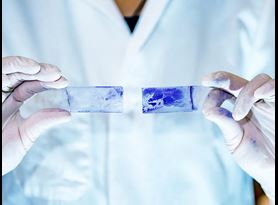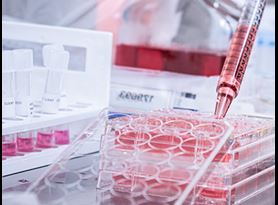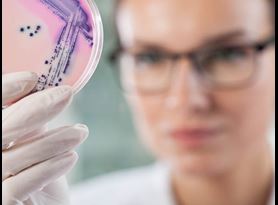Registrants seeking claims for sanitizers must comply with guidance published by the EPA. АФУХ2023ШЋФъе§АцУтЗбзЪСЯ has extensive experience testing both food contact sanitizers and non-food contact sanitizers to in support of EPA product registration and approval of claims.
EPA guidance outlines the criteria for registrants seeking claims for food contact sanitizers and non-food contact sanitizers. Sanitizers that have been approved for use on a food contact surface are classified as food contact sanitizers, while sanitizers that have been approved for use on a non-food contact surface are referred to as non-food contact sanitizers. АФУХ2023ШЋФъе§АцУтЗбзЪСЯ’s comprehensive sanitizer microbiology testing services include testing to established methodology to generate required data for product registration. Our industry-leading microbiologists have decades of experience testing products to established methods and custom protocols. As the most frequently used methodology is listed, connect with us today to explore alternative methods.
Food contact sanitizer efficacy testing
АФУХ2023ШЋФъе§АцУтЗбзЪСЯ tests food contact sanitizers for antimicrobial efficacy to standard AOAC methods, including, but not limited to:
AOAC Method 955.16 Available Chlorine in Disinfectants - In this method, a sample of the disinfectant is inoculated with a suspension of representative test organism. After 1 minute, a sample is removed and transferred to a tube containing a liquid subculture medium specifically selected to neutralize the test substance active and to recover any surviving test organism. Thirty seconds later, the same sample is re-inoculated. After an additional 1 minute of exposure, a second sample is removed and recovered. This is repeated until 10 samples have been removed. Side-by-side controls are identically evaluated using 50 ppm, 100 ppm and 200 ppm sodium hypochlorite. The subculture tubes are incubated, examined for growth, and the test subcultures are compared to the control sodium hypochlorite tubes.
For food-contact sanitizing rinses, test results should demonstrate product concentrations equivalent in activity to 50, 100, or 200 ppm of sodium hypochlorite. For hand sanitizers, test results should demonstrate product concentrations equivalent in activity to 50 ppm of sodium hypochlorite. Typical test organisms include Staphylococcus aureus and Salmonella enterica serovar Typhi. Other foodborne pathogens are often tested as well.
AOAC Method 960.09 Germicidal and Detergent Sanitizing Action of Disinfectants - In this method, a sample of the disinfectant is inoculated with a suspension of representative test organism. Following a 30 second exposure, the sample is neutralized and quantitatively assayed for survivors. The resulting plates are incubated, the number of survivors is enumerated and a percent and log10 reduction is determined as compared to a population control.
In order to successfully demonstrate sanitizing efficacy, the product must demonstrate a 99.999% (or 5 log10) reduction. Typical test organisms include Staphylococcus aureus and Escherichia coli. Additional food-borne pathogens of interest are often tested as well.
Non-food contact sanitizer efficacy testing
АФУХ2023ШЋФъе§АцУтЗбзЪСЯ’s non-food contact sanitizer efficacy testing is performed in accordance with ASTM methodology, which includes, but is not limited to:
ASTM E1153 Standard Test Method for Efficacy of Sanitizers Recommended for Inanimate Non-Food Contact Surfaces - In this method, a series of glass slides (“carriers”) are inoculated with a representative test organism and the carriers are dried. The carriers containing the dried organism film are then sequentially treated with the product in a manner that represents its intended use and are exposed for a predetermined exposure time. After exposure, the carriers are neutralized and quantitatively assayed for survivors. The resulting plates are incubated, the number of survivors is enumerated and a percent reduction is determined as compared to an untreated population control.
In order to successfully demonstrate sanitizing efficacy, the product must demonstrate a 99.9% reduction. Typical test organisms include Staphylococcus aureus and Klebsiella aerogenes or Klebsiella pneumoniae. Additional pathogens of clinical, occupational or household relevance are often tested as well.
Laundry sanitizer testing
Our antimicrobial experts evaluate laundry sanitizers using established ASTM methods, including:
ASTM E2274 and E2406 Standard Test Method for the Evaluation of Laundry Sanitizers - In this method, a series of fabric swatches are inoculated with the test organism and are dried. The swatches containing the dried film of test organism are placed inside fabric-wrapped spindles and are treated in a simulated laundry apparatus. Following treatment, the swatches and a sample of the wash water are removed and are assayed for surviving test organism. The resulting plates are incubated, the survivors are enumerated and a percent reduction is determined on the test carriers as compared to a population control.
In order to successfully demonstrate sanitizing efficacy, a 99.9% reduction of the test organism must be demonstrated on the treated fabric swatches and in the treated wash water as compared to the population control. Typical test organisms include Staphylococcus aureus, Pseudomonas aeruginosa and Klebsiella pneumoniae.
Hand sanitizer efficacy testing
АФУХ2023ШЋФъе§АцУтЗбзЪСЯ has extensive experience testing hand sanitizers to standard ASTM methodology, including those described below, to determine antimicrobial efficacy.
ASTM E2315 Time Kill Assay for Antimicrobial Agents - In this method, a sample of the product is inoculated with a suspension of a representative test organism. After a series of pre-selected exposure times, a sample is removed, neutralized and quantitatively assayed for surviving test organism. The resulting plates are incubated, the survivors are enumerated and percent and log10 reductions are determined for each time point as compared to a population control.
Common test organisms used to evaluate hand sanitizers as recommended by the Tentative Final Monograph include but are not limited to: Staphylococcus aureus, Acinetobacter baumanii, Klebsiella pneumoniae, Streptococcus pyogenes, Pseudomonas aeruginosa, Burkholderia cepacia, and Serratia marcesens.
ASTM E2783 Assessment of Antimicrobial Activity for Water Miscible Compounds Using a Time-Kill Procedure - In this method, a sample of the product is inoculated with a suspension of a representative test organism. After a series of pre-selected exposure times, a sample is removed, neutralized and quantitatively assayed for surviving test organism. The resulting plates are incubated, the survivors are enumerated and percent and log10 reductions are determined for each time point as compared to a population control.
Common test organisms used to evaluate hand sanitizers as recommended by the Tentative Final Monograph include but are not limited to: Staphylococcus aureus, Acinetobacter baumanii, Klebsiella pneumoniae, Streptococcus pyogenes, Pseudomonas aeruginosa, and Serratia marcesens.
Carpet sanitizer testing
АФУХ2023ШЋФъе§АцУтЗбзЪСЯ performs carpet sanitizer studies to determine the effectiveness of the Sponsor’s product as a carpet sanitizer fin accordance with EPA Carpet Sanitizer methodology.
Carpet Sanitizer - Test organism cells dried on carpet squares are exposed to the test substance for a specified exposure time. After exposure, the carpet squares are transferred to vessels containing neutralizer and assayed for survivors.
The EPA efficacy performance requirements for label claims state that the test substance must demonstrate a minimum 99.9% reduction of the test organism as compared to the scrubbed population control.
Other sanitizer antimicrobial efficacy test methods
In addition to the methods described, АФУХ2023ШЋФъе§АцУтЗбзЪСЯ can develop custom microbiological testing protocols to evaluate the efficacy of sanitizers for a range of intended applications and use. We also have experience testing to the following method:
Ex-Vivo Antimicrobial Evaluation of Topical Products Using a Vitro-Skin® Model - This test method is used to evaluate the effectiveness of topical skin products against single selected microorganisms using an ex-vivo skin model. A film of cells dried on the surface of a simulated skin substrate is exposed to the test substance for a specified exposure time. After exposure, the carriers are neutralized and assayed for survivors.
This test method is designed to examine the rate-of-kill of a test substance after inoculation with a test organism. Results are expressed in percent and log reduction of the test organism. Minimum percent and log reduction values do not exist to specify a “passing” or “failing” test substance.
The АФУХ2023ШЋФъе§АцУтЗбзЪСЯ advantage
For more than three decades, АФУХ2023ШЋФъе§АцУтЗбзЪСЯ has been the trusted partner for leading developers, manufacturers, and marketers of food contact and non-food contact sanitizers. As a leader in antimicrobial testing, our consultative scientific and regulatory experts stay up-to-date with market trends and regulatory guidance, including the various methods for testing sanitizers for a wide ranges of intended uses and applications.
For more information about АФУХ2023ШЋФъе§АцУтЗбзЪСЯ’s antimicrobial sanitizer efficacy testing, contact us today.
Learn more

Microbiology Testing
АФУХ2023ШЋФъе§АцУтЗбзЪСЯ offers a diverse array of microbiology testing services and can serve clients from early-stage antimicrobial product development and non-GLP screen testing all the way through GLP testing for submission.

Virology Testing
АФУХ2023ШЋФъе§АцУтЗбзЪСЯ offers GLP and cGMP virology testing options to serve our clients in the antimicrobial and pharmaceutical industries.

About АФУХ2023ШЋФъе§АцУтЗбзЪСЯ Eagan
АФУХ2023ШЋФъе§АцУтЗбзЪСЯ Eagan is the premier contract antimicrobial testing laboratory and expert partner to the developers, manufacturers and users of antimicrobial pesticide and biocide products. We have more than 30 years of experience generating GLP-compliant data.

Client Portal
Secure 24/7 access to your test result information, which you can download directly to your information management system.

